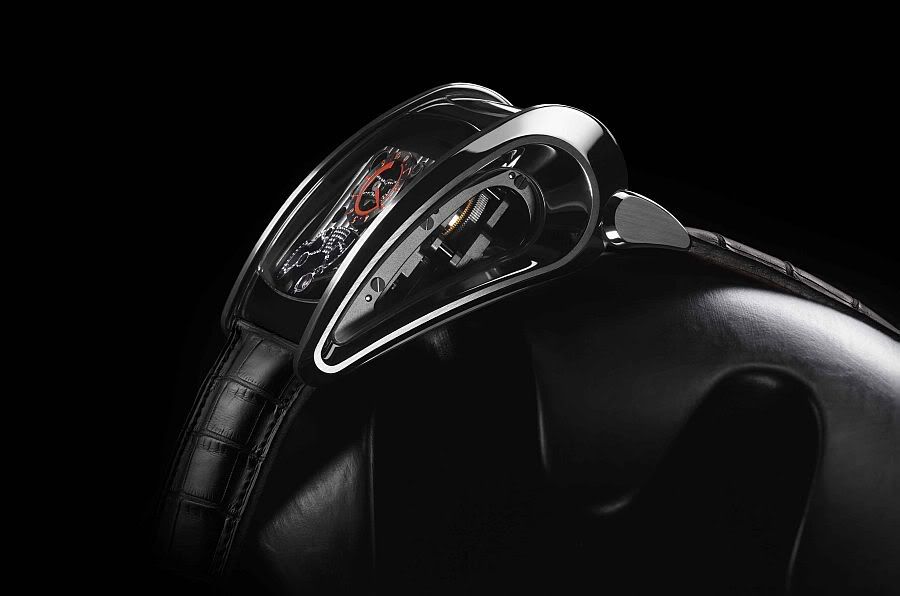Monday, December 6, 2010
Pushing The Envelope
As we approach the quincentennial of the first worn timepiece, I find myself admiring this beautiful specimen, the Parmigiani Bugatti Super Sport. In 1511, Peter Henlein created the first pocket watch, an evolution of the technology of spring-driven clocks, but, as these masterpieces were nothing short of heavy, they were typically attached to clothing or supported by the user in some other manner. These timepieces utilized the most simplistic time display possible, a single hand to indicate the hour, and even that was a rough approximation. Though these proved themselves as both a marvel of ingenuity and fashion, designers set about to both lighten them and provide a more exact measure of time. They couldn't help but feel the need to draw out some way to create a more accurate measurement as well, and they pushed the limits of tension on the mainspring, but, eventually, they introduced a balance spring in 1657, and the world was finally blessed with a minute hand. Though, after doing some light reading, I could share a sizable amount of words on the history of watches, let me skip ahead to 1868. Up to that point, many advancements had been made increasing the accuracy of these timepieces, and the art of their style flourished, but these pieces of jewelry remained chained to the pockets of their owners. In 1868, Patek Philippe created the first wristwatch as a piece of jewelry for women, and that remains a technological wonder in and of itself, but it wasn't until the first World War that these small clocks became a staple of society. At that point, fighters found it to be a much more practical reference point in battle. Sure, the upper class had plenty of access to such works, but it had finally become financially obtainable for the middle class, and its adoption by fighters, made it a mainstay and a reference point of our culture. Designers and inventors had pushed the envelope of what was possible, redefining the limits of fashion, art and craftsmanship, and that is something we all look back on with a sort of reverence.
Since then, it seems we had accepted a ceiling, an upper limit, to what is suitable, acceptable, and possible for these accent pieces. Sure, we tried some new materials, some new digital display methods, and a few subtle variations on its flat shape, but the overall concept had become almost too concrete to change. Recently, in its third collaboration with the French car company, Bugatti, this Swiss retailer of opulence, Parmigiani, decided it was time to throw that all into the air and got back to the drawing board. Their goal seems to have been to both pay tribute to the fine lines of the French super car as well redefine the limits of the fashion world, at least with regards to watches. Well, let me tell you, they absolutely succeeded. They decided to stretch its face onto an elevated and angled plane, and this amazing feat does more than I think I can put into words. It changes our perception of what a watch has to look like, it allows us to admire the working components without having to look through the display components, and, somehow, simultaneously allows the user a facilitated access while maneuvering at high speeds. So, basically, they both pay tribute to the graceful lines of the sleek wing of its namesake while allowing the user to read it more easily while racing through the streets behind its wheel. It's a masterpiece of form and function that stretches the limits in more ways than one and I can't help but fall in love with it.
There is, however, one thing with which I can't fall in love, the price tag. This limited run of thirty timepieces made of 18k white gold reserves itself for those with the riches to afford the matching car, and they expect to price each one at an estimated $259,000. Though I find myself fascinated with its lines and the beauty of its form, even drawn in by the orange color of its hands, an homage to the beautiful Bugatti Veyron 16.4 that it finds itself matching, I cannot ever expect to own it. I will have to admire it from a distance, much like a fine piece in a museum. In the end, much like its design, its price tag finds itself energetically pushing the envelope.
Links:
Parmigiani: Website
History of Watches: Paralumun Wikipedia Watches Addict
Subscribe to:
Post Comments (Atom)

No comments:
Post a Comment